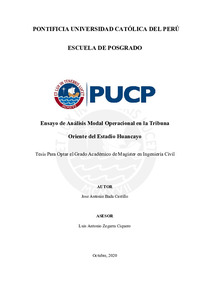| dc.contributor.advisor | Zegarra Ciquero, Luis Antonio | |
| dc.contributor.author | Bada Castillo, Jose Antonio | |
| dc.date.accessioned | 2021-12-03T22:09:58Z | |
| dc.date.available | 2021-12-03T22:09:58Z | |
| dc.date.created | 2020 | |
| dc.date.issued | 2021-12-03 | |
| dc.identifier.uri | http://hdl.handle.net/20.500.12404/21076 | |
| dc.description.abstract | Los estadios deportivos son estructuras sometidas a cargas dinámicas producidas por el
salto rítmico de los espectadores. Estas cargas pueden ocasionar vibraciones inadmisibles
para el confort humano y fallas estructurales por resonancia. La resonancia es un
fenómeno que ocurre cuando la frecuencia de la carga aplicada es igual a la frecuencia
natural de la estructura (Clough y Penzien, 2003). Un caso práctico donde se detectaron
vibraciones y fisuras es la tribuna Oriente del Estadio Huancayo. Es más, el aforo de esta
tribuna fue reducida debido a la existencia de fisuras y problemas de inestabilidad
(Chavez, 2011). Por ello, el presente trabajo tiene como objetivo la protección de tribunas
de concreto armado ante vibraciones causadas por la actividad rítmica de los
espectadores. Para lograr nuestro objetivo fue necesario estudiar el comportamiento
dinámico de la tribuna, determinar el daño que las vibraciones podrían causar y proponer
un reforzamiento que contribuya con el confort del público y con la seguridad estructural
de la tribuna. Bajo estas circunstancias, se realizó un ensayo de Análisis Modal
Operacional (OMA) con un sismómetro que registró señales dentro de una banda de
frecuencias entre 0.20 y 40 Hz y una frecuencia de muestreo de 200 Hz. Estos registros
fueron procesados para conocer la frecuencia fundamental de 4.45 Hz en la tribuna y la
frecuencia fundamental del suelo que se encuentra entre 0.60 y 2.00 Hz. Con estos
resultados se implementó y validó el modelo numérico de Elementos Finitos (FEM) de la
tribuna y se evaluó su comportamiento debido al salto rítmico de los espectadores con
una frecuencia excitadora de 3.50 Hz. Por consiguiente, se planteó el reforzamiento
estructural de la tribuna Oriente del Estadio Huancayo. | es_ES |
| dc.description.abstract | Sports stadiums are structures subjected to dynamic loads produced by the synchronized
jumping of spectators. These loads can cause inadmissible vibrations for human comfort
and structural failure due to resonance. Resonance is a phenomenon that occurs when the
frequency of the applied load is equal to the natural frequency of the structure (Clough
and Penzien, 2003). A practical case where vibrations and cracks were detected is the
East grandstand of the Huancayo Stadium. Furthermore, the capacity of this grandstand
was reduced due to the existence of cracks and instability problems (Chavez, 2011).
Therefore, the present work aims to protect reinforced concrete grandstands against
vibrations caused by jumping by spectators. To reach our objective, it was necessary to
study the dynamic behavior of the grandstand, determine the damage that vibrations could
cause and propose a reinforcement that contributes to the comfort of the public and the
structural safety of the grandstands. Under these circumstances, an Operational Modal
Analysis (OMA) test was carried out with a seismometer that recorded signals within a
frequency band between 0.20 and 40 Hz and a sampling frequency of 200 Hz. These
records were processed to know the fundamental frequency of 4.45 Hz in the grandstand
and the fundamental frequency of the ground that is between 0.60 and 2.00 Hz. With these
results, the numerical model of Finite Elements (FEM) of the grandstand was
implemented and validated and its behavior was evaluated due to the synchronized jump
of the spectators with an exciting frequency of 3.50 Hz. Consequently, the structural
reinforcement of the East grandstand of the Huancayo Stadium was proposed. | es_ES |
| dc.language.iso | spa | es_ES |
| dc.publisher | Pontificia Universidad Católica del Perú | es_ES |
| dc.rights | info:eu-repo/semantics/openAccess | es_ES |
| dc.rights.uri | http://creativecommons.org/licenses/by/2.5/pe/ | * |
| dc.subject | Cargas dinámicas | es_ES |
| dc.subject | Construcciones de concreto armado--Vibración | es_ES |
| dc.subject | Estadios deportivos--Dinámica de estructuras | es_ES |
| dc.title | Ensayo de Análisis Modal Operacional en la Tribuna Oriente del Estadio Huancayo | es_ES |
| dc.type | info:eu-repo/semantics/masterThesis | es_ES |
| thesis.degree.name | Maestro en Ingeniería Civil | es_ES |
| thesis.degree.level | Maestría | es_ES |
| thesis.degree.grantor | Pontificia Universidad Católica del Perú. Escuela de Posgrado. | es_ES |
| thesis.degree.discipline | Ingeniería Civil | es_ES |
| renati.advisor.dni | 07778632 | |
| renati.advisor.orcid | https://orcid.org/0000-0001-5923-5785 | es_ES |
| renati.author.dni | 40876125 | |
| renati.discipline | 732267 | es_ES |
| renati.juror | Montalbetti Solari, Juan Antonio Alejo | |
| renati.juror | Zegarra Ciquero, Luis Antonio | |
| renati.juror | Chacara Espinoza, Cesar Javier | |
| renati.level | https://purl.org/pe-repo/renati/level#maestro | es_ES |
| renati.type | https://purl.org/pe-repo/renati/type#tesis | es_ES |
| dc.publisher.country | PE | es_ES |
| dc.subject.ocde | https://purl.org/pe-repo/ocde/ford#2.01.01 | es_ES |






